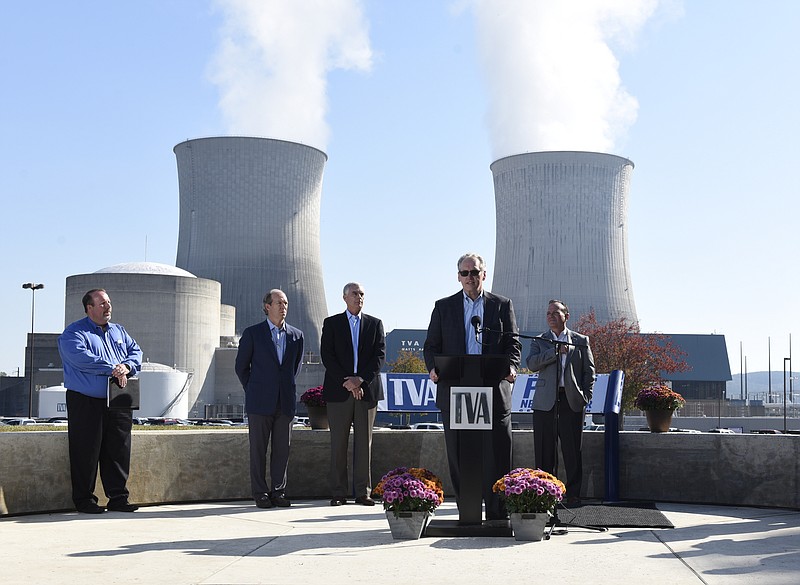Since TVA began building Watts Bar in 1973, TVA has spent more than $12 billion to finish the two reactors - more than triple what was spent at either the twin-reactor Sequoyah plant near Soddy-Daisy or the three-unit Browns Ferry Nuclear Plant near Athens, Ala.
And last month, TVA's board voted to provide up to $200 million more to finish a second unit at Watts Bar after crews determined work could not be finished within the $4.5 billion previously allocated for the completion project.
After 43 years of stops and starts, the Unit 2 reactor at the Watts Bar Nuclear Power Plant, America's first new nuclear power plant to be built in the 21st century, should be completed and generating power by June - at a cost far below what other new nuclear plants are costing to build.
The $4.7 billion expense of Watts Bar Unit 2 that has not already been paid by ratepayers will be less than half the cost of similar new nuclear plants being built in Georgia and South Carolina.
Despite the rising cost of the 1,150-megawatt reactor at the Spring City, Tenn., plant, TVA President Bill Johnson said the new reactor at Watts Bar "will be an outstanding investment for the people of the Tennessee Valley."
"It will be a 60-year, maybe even an 80-year producer of carbon-free power with a very stable fuel cost," Johnson said. "You have a significant capital cost to build a nuclear reactor, but over the long term it is a reliable, low operating cost of power."
Critics of nuclear power said the rising cost of Watts Bar reflects ongoing problems by the industry in bringing projects to completion at forecasted prices. Cost overruns in the past at nuclear construction projects - sometimes more than 10 times their original forecasts - have made Wall Street investors and many utilities wary about building more nuclear power plants.
"Here we go again," Don Safer, chairman of the Tennessee Environmental Council, said after learning of the higher cost to finish Watts Bar Unit 2. "I am not surprised that the costs keep going up; cost overruns are almost a given in nuclear construction."
Mike Skaggs, the project manager for Watts Bar, said that flood prevention steps required to be taken after the Fukushima nuclear plant meltdown in Japan five years ago added more than $300 million of extra expense to the new reactor - more than $120 million above what was forecast four years ago when Skaggs took over the construction project. Additionally, Skaggs said minor equipment problems have required some extra time and expense to bring the unit online after regulators granted the Tennessee Valley Authority an operating license for Watts Bar Unit 2 in October.
TVA loaded fuel in the new reactor in early December and expects to bring the reactor to criticality and begin producing limited power by this spring. The reactor should be in full production by June, Skaggs said.
"We're still working toward completion of the project, and safety is still [of] the utmost importance to make sure that when we get done, Watts Bar Unit 2 will be safe and reliable," Skaggs said. "We're in the middle of power ascension testing and we're making sure that systems and processes work effectively."
Stephen Smith, executive director for the Southern Alliance for Clean Energy and a member of the review panel for TVA's latest integrated resource plan, questioned the assertion that Watts Bar will prove to be reliable over the long term.
"That has not always been true of nuclear power, even at other TVA plants," Smith said. "I think the jury is still out about Watts Bar, and for the future we just don't think nuclear power makes good environmental or economic sense for additional power."
Smith questioned why TVA directors took a notational vote among members by phone or proxy in January, rather than at one of its public meetings, to authorize another $200 million for the project.
"Why do they make these major investment decisions in private?" Smith asked.
The project was already authorized, and Skaggs said the extra funding ensures work can be completed to bring the unit online as scheduled.
With the addition of Watts Bar Unit 2 this summer, TVA will derive more than 40 percent of its power generation from nuclear power and more than half from sources other than burning of fossil fuels, which once accounted for more than two thirds of TVA power. The change in generation, combined with pollution controls on TVA's remaining coal plants, has cut the sources of smog - sulfur dioxide and nitrogen oxides - by more than 90 percent - and trimmed carbon emissions linked with global warming by more than 30 percent since 2005.
Johnson said TVA appears well suited to meet the new Clean Power Plan regulations for carbon reductions.
Contact Dave Flessner at dflessner@timesfreepress.com or 757-6340.
